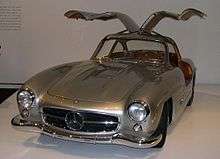Mercedes-Benz W194
 | |
| Category | Endurance racing |
|---|---|
| Constructor | Mercedes |
| Designer(s) | Rudolf Uhlenhaut |
| Technical specifications | |
| Engine | Mercedes-Benz |
| Competition history | |
| Notable entrants | Daimler Benz AG |
| Notable drivers |
|
The Mercedes-Benz W194 (also 300SL) was the Mercedes-Benz entry for the 1952 Sportscar racing season, its first after World War II.
Powered by a 3.0 litre SOHC straight-6, it ran off an impressive string of victories that included 24 Hours of Le Mans, Bern-Bremgarten, the Eifelrennen at Nürburgring, and Mexico's Carrera Panamericana.[1]
The W194 was succeeded by the Mercedes-Benz W196 on the track, and led to the iconic Mercedes 300SL W198 Gullwing road car in 1954.[2]
Design
The racing W194 300SL was built around a welded aluminum tube spaceframe chassis to offset its relatively underpowered carbureted engine. Designed by Daimler-Benz's chief developing engineer, Rudolf Uhlenhaut, the metal skeleton saved weight while still providing a high level of strength. Since it enveloped the passenger compartment traditional doors were impossible, giving birth to the model's distinctive gull-wing arrangement.
Like the 300SL it birthed, the W194 borrowed its overhead cam straight 6 engine from the regular four-door 300 (W189 "Adenauer") luxury tourer introduced in 1951, with triple two-barrel Solex carburators from the exclusive 300S (W188). Designed with an innovative diagonal aluminum head (that allowed for larger intake and exhaust valves) and canted at a fifty-degree angle[2] to the right to fit under the W194's considerably lower hoodline, it produced 175 hp (130 kW) in racing trim, considerably up from the 300s' 150 hp (112 kW). Maximum torque was 207 N·m (153 lb·ft). Top speed was 290 km/h (180 mph).[2]
Aerodynamics played an important role in the 2497 pound[2] car's speed. Unlike many cars of the 1950s, steering was relatively precise and the four-wheel independent suspension allowed for a reasonably comfortable ride and markedly better overall handling. However, the rear swing axle, jointed only at the differential, not at the wheels themselves, could be treacherous at high speeds or on imperfect roads due to extreme changes in camber. The enormous fuel tank capacity also caused a considerable difference in handling depending on the quantity of fuel on board.
Racing history

In 1952, the W194[1] scored overall wins at the 24 Hours of Le Mans, in Bern-Bremgarten, in the sportscar race of the Eifelrennen at the Nürburgring, and in Mexico's Carrera Panamericana. It also managed second and fourth places at its first outing, the Mille Miglia in 1952 and won the Rally Stella Alpina in 1955 in its last edition.[3]
These successes, especially those on the high speed open road races, were rather surprising as the W194 engine was fitted only with carburetors, producing 175 hp (130 kW), which was not only less than the competing cars by Ferrari and Jaguar, but also less than the 300SL road car developed from it and introduced 1954. Low weight and low aerodynamic drag made the W194 fast enough to be competitive in endurance races.
300SL road car

Daimler-Benz's official importer in the USA, New York Mercedes distributor Max Hoffman, suggested to company management in Stuttgart that a street version of the W194 would be a commercial success, especially in America. The result was an icon, the 1954 Mercedes-Benz 300SL Gullwing (W198).
More than 80% of the vehicle's total production of approximately 1400 units were sold in the US, making the Gullwing the first Mercedes-Benz widely successful outside its home market and thoroughly validating Hoffman's prediction. The 300SL is credited with changing the company's image in America from a manufacturer of solid but staid luxury automobiles to one capable of rendering high-performance sports cars.
See also
References
- 1 2 the original 300SL (model W194)
- 1 2 3 4 http://www.motortrend.com/classic/features/12q3_1952_mercedes_benz_300sl_w194_00002/
- ↑ "Albo d'oro Stella Alpina". scuderiatrentinastorica.it.